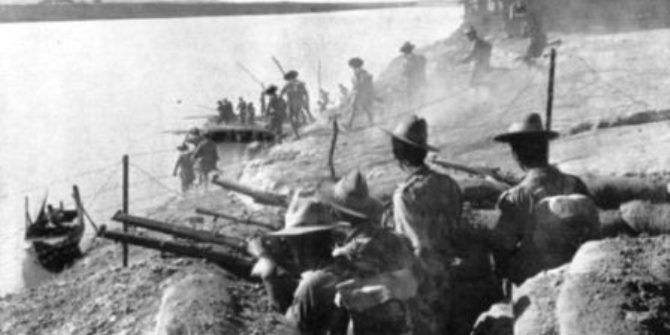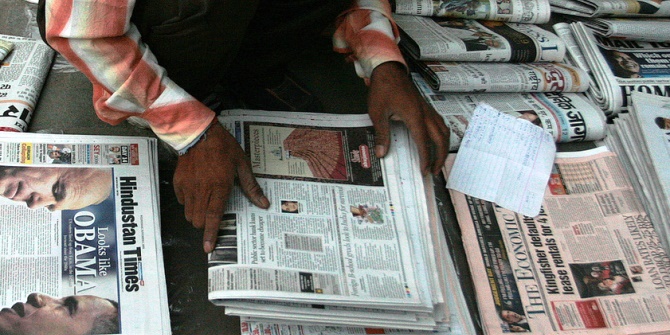The British-Indian army fighting in Burma during 1942 is sometimes misleadingly referred to as a ‘Forgotten Army’. In fact, the army’s long retreat was given good coverage in the western press which provided twenty-six correspondents to cover the campaign. Philip Woods’ new book is the first scholarly analysis of media coverage of this retreat, focusing on newsreel, magazine and newspaper correspondents. It argues for the historical value of the journalists’ contribution, most especially in their published memoirs. The book has implications for the study of journalism and the history of Burma and India.
The British defeat in Burma at the hands of the Japanese in 1942 marked the longest retreat in British army history and the beginning of the longest campaign in the war. It also, arguably, marked the beginning of the end of British rule, not only in Burma but also in south and south east Asia more broadly. There have been many studies of the military and civilian experiences during the retreat but my book, Reporting the Retreat: War Correspondents in Burma 1942 (published by Hurst on 3 November 2016) is the first to look at the way the campaign was represented through the western media: newspapers, pictorial magazines, and newsreels. There were some twenty-six accredited war correspondents covering the campaign, and almost half of them wrote books about their experiences, mostly within a year or two of the defeat. Their accounts were heavily criticised by government officials as being misinformed and sensationalist. Historians have tended to avoid using them, except to add colour to their accounts, perhaps because they are seen as being too patriotic and optimistic in their coverage and thus giving the public an unrealistic view of how the war was progressing.

My book draws on archival sources to assess the validity of these criticisms. How do the war correspondents see their role? It is clichéd to talk of war journalism in terms of ‘The First Draft of History’ but in view of wartime censorship restrictions it does seem that correspondents were keen to have their experiences recorded, especially when they could publish less censored versions usually within a year or two of the key campaigns they were covering. What were the constraints on war correspondents, other than censorship? Clearly, there were limits resulting from the nature of the media that they worked in, often exacerbated by wartime considerations, such as the reduction in newspaper space. This can be seen very clearly in the case of the newsreel cameramen, two of whom covered the Burma retreat. By examining their films and the supporting documentation, one can see how they needed to meet the requirements of the newsreel business, which acted as a largely patriotic, rather anodyne adjunct to the main films which audiences had come to see. Even so, the newsreels and the photographs which appeared in the popular pictorial magazines of the day, provide very good evidence of the way that the war was represented to the British, American and Australian publics in the days before television.
There is, of course, the issue of authenticity in the reporting: did the journalists make up stories or present them in a misleading way? Evelyn Waugh’s satirical novel Scoop (1938) famously depicted the way in which journalists would sit in the bar far from the action and file reports which started ‘From the battle-front…’ Journalists in Burma were sometimes caught out, claiming to be witnessing events first-hand when they were reporting second-hand accounts. From the First World War there were clear examples of battle scenes being faked or re-enacted for the cameras. During the Burma retreat I did find a clear case where a battle was re-staged for newsreel and still cameramen, but this was exceptional and went against clear company guidelines. As in the First World War, it resulted from the difficulty of getting good action pictures, in this case because of jungle and night-time fighting.
Generally speaking, I believe the war correspondents did a good job within the constraints they faced. The job was both dangerous and very emotionally taxing. The Hemingway-style machoism expected of them served to cover up what today would be described as post-traumatic stress. It made a definite difference to the quality of the reporting when they were able to cover the fighting directly, as against newspapers relying on army communiques. However, it is in their memoirs rather than in their contemporary dispatches that the best quality is to be found. Using notes and photographs taken at the time, they reconstructed fuller and more analytical accounts of the campaign. Most correspondents had left-wing sympathies, which were usually strengthened by their wartime experiences. They pressed for political concessions to be made to India and Burma if the allies were to win the support in these countries that was necessary to win the war. They were saw the need to support Nationalist China under Chiang Kai-Shek, whose armies playing a major role in Burma, although they provided damning evidence of the Chinese corruption and politicking that was undermining the Lend-Lease supplies sent by the USA. The American and Australian reporters were the most critical of the hierarchical, racist and bureaucratic nature of British colonial regimes in India, Burma and Malaya.
Although my book may seem narrowly focused on a few months in 1942, it has much broader implications both for the study of journalism and for the history of Burma and India. A good deal of attention has been given to the loss of Singapore in February 1942 but the fall of Rangoon and the subsequent inevitable loss of Burma was actually much more serious, opening up major threats to India and China. The loss of Burma’s rice exports to India and the implementation of scorched earth tactics would soon have disastrous effects on Bengal, contributing to devastating famine in 1943. The mass migration of hundreds of thousands of Indian refugees from Burma and the tragic loss of life involved contributed to a devastating blow to Britain’s image as protector of its citizens in the region and proved impossible to repair. I examine the way that sheltering and evacuation from Rangoon was mishandled by the Government of Burma and its hapless Governor, Sir Reginald Dorman-Smith. I also look at the way that journalists had to contain their private views on these issues in their newspapers but made them very clear in their later memoirs. The Government of Burma continued to operate in Simla after the retreat and devised detailed plans for their post-war return. But as Chris Bayly and Tim Harper have so admirably shown in Forgotten Armies (Penguin: 2005), there was to be no lasting return for either the Governor nor British rule in Burma. The war had given rise to more radical nationalisms in the region that could not be assuaged.
Reporting the Retreat: War Correspondents in Burma 1942 is published today. Pre-order a your copy here.
The LSE South Asia Centre is running series of events entitled Colony As Empire: Histories from Whitehall to mark 70 years of Indian and Pakistani independence. Find out more about the series and upcoming events here.
This article gives the views of the author, and not the position of the South Asia @ LSE blog, nor of the London School of Economics. Please read our comments policy before posting.
About the Author
Dr Philip Woods studied History at LSE and the School of Oriental and African Studies (SOAS), University of London. He has published on British-Indian politics after World War I, and the British use of film as propaganda in India. He has taught at the University of West London, Kingston University and now teaches at New York University in London. He can be contacted at pgw1@nyu.edu






